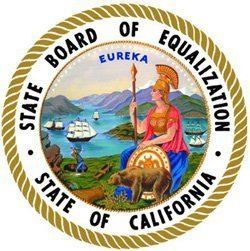Founded 1879 | ||
 | ||
The State Board of Equalization (BOE) is a public agency charged with tax administration and fee collection in the state of California in the United States. The authorities of the Board fall into four broad areas: sales and use taxes, property taxes, special taxes, and acting as an appellate body for franchise and income tax appeals (which are collected by the Franchise Tax Board). The BOE is the only publicly elected tax commission in the United States.
Contents
- History
- Equalization districts
- First district
- Second district
- Third district
- Fourth district
- Tax and fee programs
- Sales and Use Tax Programs
- Special Tax and Fee Programs
- Property Tax Programs
- Tax Appellate Programs
- References
The board is made up of four directly elected members, each representing a district for four-year terms, along with the State Controller, who is elected on a statewide basis, serving as the fifth member. The current board members are:
The terms of all five members, including the State Controller, began on January 5, 2015. As of 2008, the agency employed approximately 3,950 people throughout the state.
History
The State Board of Equalization was created in 1879 by an amendment to the California Constitution. Its original mandate was to ensure that property tax assessments were uniform and equal across all counties in the state.
Prior to the creation of the state income, sales, and fuel taxes in the 1930s, California's state government was almost completely supported by property taxes, which were and still are assessed at the county level by elected assessors. Of course, assessors were tempted to boost their popularity with county voters by undervaluing voters' property (and thereby lowering their taxes). This presented the risk of counties with honest assessors paying more than their fair share of the burden of operating the state government, so the Board of Equalization was created to equalize the burden.
Equalization districts
For the purposes of tax administration, the BOE divides the state into four Equalization districts, each with its own elected board member. Following the 2011 redistricting, the new districts have been in effect since January 1, 2015.
First district
The first Equalization District is made up of the following counties: Alpine, Amador, Butte, Calaveras, El Dorado, Fresno, Inyo, Kern, Kings, Lassen, Madera, Mariposa, Merced, Modoc, Mono, Nevada, Placer, Plumas, Sacramento, San Joaquin, Shasta, Sierra, Siskiyou, Stanislaus, Sutter, Tulare, Tuolumne, Yuba, a portion of Los Angeles, and a portion of San Bernardino. Before 2015, most of this area was the second district.
Second district
The second Equalization District is made up of the following counties: Alameda, Colusa, Contra Costa, Del Norte, Glenn, Humboldt, Lake, Marin, Mendocino, Monterey, Napa, San Benito, San Francisco, San Luis Obispo, San Mateo, Santa Clara, Santa Cruz, Solano, Sonoma, Tehama, Trinity, Yolo, and Santa Barbara. Before 2015, most of this area was the first district.
Third district
The third Equalization District is made up of Ventura County and a portion of Los Angeles County, including the cities of Agoura Hills, Alhambra, Arcadia, Artesia, Avalon, Baldwin Park, Bell, Bell Gardens, Bellflower, Beverly Hills, Burbank, Calabasas, Carson, Cerritos, City of Industry, Commerce, Compton, Covina, Cudahy, Culver City, Diamond Bar, Downey, El Monte, El Segundo, Gardena, Glendale, Glendora, Hawaiian Gardens, Hawthorne, Hermosa Beach, Hidden Hills, Huntington Park, Inglewood, La Cañada Flintridge, La Habra Heights, La Mirada, La Puente, Lakewood, Lawndale, Lomita, Long Beach, Los Angeles, Lynwood, Malibu, Manhattan Beach, Maywood, Monrovia, Montebello, Monterey Park, Norwalk, Paramount, Pasadena, Pico Rivera, Redondo Beach, Rosemead, San Gabriel, San Marino, Santa Fe Springs, Santa Monica, Sierra Madre, Signal Hill, South El Monte, South Gate, South Pasadena, Temple City, Torrance, Vernon, Walnut, West Covina, West Hollywood, Westlake Village, and Whittier.
Fourth district
The fourth Equalization District is made up of the following counties: Imperial, Orange, Riverside, San Diego, a portion of Los Angeles, and a portion of San Bernardino.
Tax and fee programs
The State Board of Equalization administers the following tax and fee programs:
Sales and Use Tax Programs
For more information on sales and use taxes in California, see the "California" section of Sales taxes in the United States.
